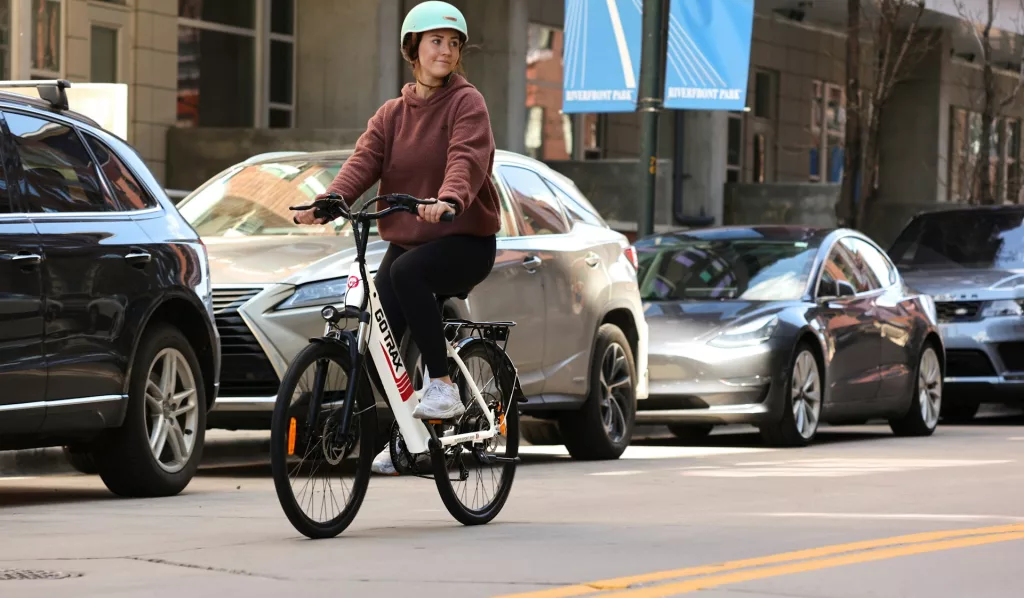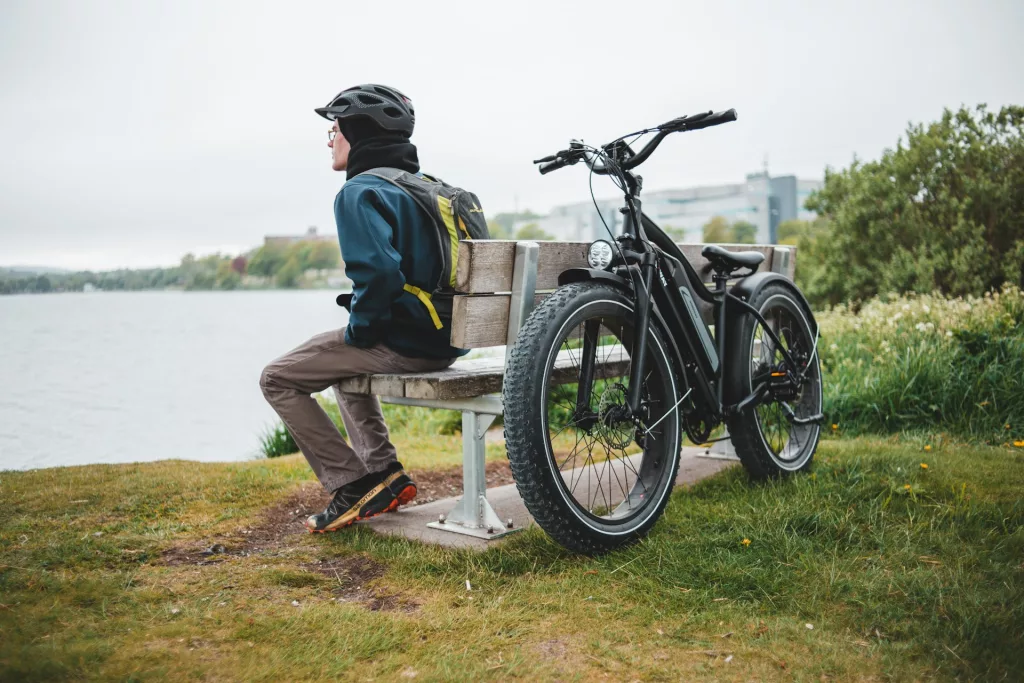
In the United Kingdom, electric bikes are legal and classified as ‘electrically assisted pedal cycles’ (EAPCs). You can ride an EAPC if you’re 14 or older, as long as it meets specific requirements:
- Pedals: An EAPC must have pedals that can be used to propel it.
- Power Output: The electric motor’s maximum power output should not exceed 250 Watts.
- Speed Limit: It should not be able to propel the bike when it’s traveling more than 15.5 mph.
If an electric bike meets these EAPC rules, it’s considered a normal pedal bike. You can ride it on cycle paths and anywhere else pedal bikes are allowed.
However, any electric bike that doesn’t meet these rules is classified as a motorcycle or moped and requires registration, tax, and a driving license
What Are Electric Bikes?
Electric bikes, commonly referred to as e-bikes, are bicycles equipped with an integrated electric motor that assists with propulsion. E-bikes come in various forms, but they generally fall into two main categories: pedal-assist (also known as pedelecs) and throttle-based e-bikes.
Pedal-Assist E-Bikes
These bikes provide electric assistance only when the rider is pedalling. The motor amplifies the rider’s pedalling effort, making it easier to tackle hills and ride longer distances. The level of assistance can usually be adjusted, allowing the rider to choose how much help they receive from the motor.
Throttle-Based E-Bikes
These bikes can be propelled by the motor alone, without the need for pedalling. A throttle on the handlebar controls the motor, allowing the rider to engage the electric assistance at will. Some models combine both throttle and pedal-assist features.
Legal Definition and Classification
In the United Kingdom, the legal definition and classification of e-bikes are outlined in the Electrically Assisted Pedal Cycles (EAPC) Regulations. For an e-bike to be classified as an Electrically Assisted Pedal Cycle (EAPC) and be legally ridden on public roads without the need for a licence, insurance, or vehicle registration, it must meet specific criteria.
EAPC Criteria
- Power Output: The electric motor must have a maximum power output of 250 watts.
- Speed Limit: The motor must not provide assistance when the bike is travelling at more than 15.5 miles per hour (25 km/h). Beyond this speed, the rider must pedal without electric assistance.
- Pedal Assistance: The motor must only assist when the rider is pedalling. Throttle-based e-bikes that can be powered solely by the motor are not classified as EAPCs under UK law.
E-bikes classified as EAPCs are treated the same as regular bicycles under the Highway Code. This means they can be used on cycle paths and roads, but not on pavements designated for pedestrian use only.
Design Requirements
- Pedals: The bike must be equipped with pedals that can be used to propel it.
- Marking: The bike must display a visible marking indicating it meets the EAPC requirements, including the power output and manufacturer information.
Rider Requirements
- Age Restriction: Riders must be at least 14 years old to legally ride an EAPC on public roads in the UK.
E-bikes that meet these criteria are classified as conventional bicycles in the eyes of the law. This classification exempts them from vehicle registration, road tax, and the requirement to have a driving licence or insurance. However, it is essential to ensure that the e-bike fully complies with these regulations to avoid legal complications.

Where Can You Ride an E-Bike?
Understanding where you can legally ride an e-bike in the UK is crucial to ensure compliance with local laws and regulations. The classification of e-bikes as EAPCs allows for flexible usage, similar to traditional bicycles, but with specific restrictions.
On Public Roads
E-bikes that meet EAPC requirements can be ridden on all public roads and cycle lanes. Riders must follow the same road rules as cyclists, including obeying traffic signals, using hand signals to indicate turns, and riding in designated bike lanes where available.
On Cycle Paths and Shared Use Paths
EAPCs are permitted on cycle paths and shared use paths. These paths are typically marked with signs indicating their use for cyclists and pedestrians. Riders should be courteous and mindful of pedestrians, maintaining a safe speed and giving way when necessary.
Restricted Areas
- Motorways and Dual Carriageways: EAPCs are not allowed on motorways and certain high-speed dual carriageways. These roads are restricted to motor vehicles due to safety concerns, as the speed differential between e-bikes and motor vehicles can create hazardous conditions.
- Pavements: Riding e-bikes on pavements intended for pedestrian use is prohibited. Pavements are reserved for walking, and cycling on them can result in fines and pose a danger to pedestrians.
Designated Cycle Zones
Many cities and towns have designated cycle zones where cycling infrastructure is prioritised. E-bike riders should take advantage of these areas, which often feature bike lanes, bike parking, and reduced vehicle traffic, enhancing safety and convenience.
Off-Road and Private Land
EAPCs can be used off-road and on private land without adhering to the same regulations as public road use. However, riders should still exercise caution and respect property boundaries and local by-laws regarding off-road cycling.
Local Regulations
Some local authorities may have additional regulations or bylaws affecting where e-bikes can be ridden. It is advisable to check with local councils for any specific restrictions or guidelines in your area.
Safety Regulations and Recommendations
Safety is paramount when riding an e-bike, and adhering to safety regulations and best practices ensures not only compliance with the law but also the well-being of the rider and others.
Safety Regulations
- Helmet Use: While not legally required for e-bike riders, wearing a helmet is highly recommended. Helmets can significantly reduce the risk of head injuries in the event of an accident.
- Lighting and Reflectors: E-bikes must be equipped with front and rear lights if ridden after dark. Reflectors are also required to increase visibility. The lights must be white at the front and red at the rear, with amber reflectors on the pedals.
- Brakes: E-bikes must have functioning front and rear brakes. Regular maintenance is crucial to ensure that the braking system is effective, especially given the additional speed and weight of an e-bike compared to a traditional bicycle.
Recommendations for Safe Riding
- Regular Maintenance: Regularly check and maintain your e-bike. This includes ensuring the battery is in good condition, the motor is functioning correctly, and all mechanical parts, such as brakes and gears, are well-maintained.
- Appropriate Clothing: Wear high-visibility clothing, especially in low-light conditions, to increase your visibility to other road users. Sturdy shoes and comfortable, weather-appropriate clothing will also enhance your safety and comfort.
- Awareness and Courtesy: Stay aware of your surroundings at all times. Use hand signals to indicate your intentions to other road users and make eye contact with drivers at intersections to ensure they see you. Be courteous to pedestrians and other cyclists, especially in shared spaces.
- Battery Safety: Follow the manufacturer’s guidelines for charging and maintaining the e-bike’s battery. Avoid overcharging and keep the battery away from extreme temperatures to prevent malfunctions or accidents.
- Secure Parking: Use a strong lock to secure your e-bike when not in use.

Author – Julie Condliffe
Julie Condliffe is a four-time bestselling author, successful property investor and an award winning solicitor. She is the founding partner of Creative Legals.